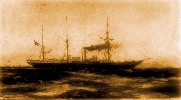

Spain was one of the few countries that had specially-constructed hydrographic vessels. Spain understood the need for good hydrographic research. By order of the Spanish navy Department one vessel was to operate off Spain (VULCANO, later repalced in 1895 by URANIA), one vessel was sent to Cuba (CRIOLLO), and one vessel was sent to the Philippines (ARGOS). Each vessel was required to be armed in case they had to function as a gunboat..
The author is searching for more information on these vessels, and
would like verification of the facts as listed below. If you can in either
of these items, please contact the website
administrator, and he will put us in contact! We need your help!
|
|
|
|
|
|
|
|
|
|
|
|
|
|
|
|
The vessel was the first iron-hulled vessel in the Spanish Navy. Her engines were produced by "Penn" of London. The vessel cost 670,000 pesetas (about 26,800 pounds). Some sources indicate that she was acquired from Mexico, either while she was on the stocks or after she was completed. She took part in the Italian expedition of 1848-49. After 1861 she was used as a hydrographic vessel. After 1890 she beame part of the Cartagena Naval Group. The vessel was dropped from the officla navy rolls in 1897. During the Spanish American War, she was have been in bad condition.
The vessel was named for the Roman god of fire.
|
|
|
|
|
|
|
|
|
|
|
|
|
|
|
|
The iron-hulled vessel was built for service in the Philippines, but the details of her service are unknown. During the Battle of Manila Bay/Cavite, she was close to the Spanish Squadron, but was not engaged in the battle. She was hit once in the battle, with little damage. In accordance with Admiral Montojo's orders, after the battle she retired into Canacao Bay and was scuttled. Later, after the conclusion of the battle a landing party from the USS PETREL set fire to her and destroyed her.
The vessel was named for the vessel of the Argonauts in Greek mythology.

|
|
|
|
|
|
|
|
|
|
|
|
|
|
|
|
The vessel was built to replace the old VULCANO. The details of her career is unknown. She was on the rolls of the Spanish Navy into the 1930's.
The vessel was named for the Greek God of astronomy.
Mitiuckov, Nick, Naval Historian, Izhevsk, Russia (personal correspondence)

